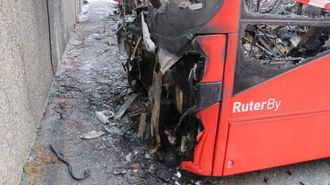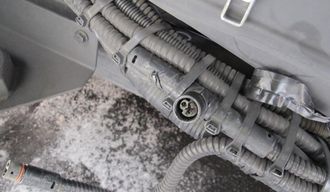Undersized and incorrectly installed conduction system that led to the generation of heat, irring, tracking resistance and serielysbue.
It was the direct cause of the four Volvo 7900 hybridbusser caught fire while she was charging at Furubakken at Bekkestua in Bærum 25. January of this year.
It writes the Accident investigation board norway (AIBN) in the report which was published Monday.
rechargeable hybrids
the Fire started in one of the buses and spread to three other parked by the side of.
Even though the buses were not in operation when they caught fire, so that the fire could not be defined as a traffic accident, the aibn has, on its own initiative chosen to investigate the fire.
the AIBN points out that the number of vehicles that can and must be connected to the external power grid will increase in the future and this will reinforce the need for follow-up.
– It must therefore be made focus on the safety of this is to prevent new fires or incidents, type SHT in the report.
Connected to the electrical protection provided by customer
Hybridbussene, which had been operated by Nettbuss since 2013, was also charging and was connected to an electrical protection provided by customer 230 V power supply voltage when the fire occurred. The buses were usually connected to twice a day.
the Volvo 7900 hybrid is a parallellhybrid where a four-cylinder, femliters diesel engine (177 hp/918 Nm) has the company of a electric motor that deliver 120 kW/800 Nm. It has been on the market since 2009. The little 1,2 kWh lithium-ion battery can not be charged in advance.
It was therefore not driftsbatteriet that was charged. At the same time, the fact that this was hybridbusser indirectly, have contributed to the fire, as some of the power went to heating of the lithium-ion battery.
The external power supply supplied bussenes kupévarmeanlegg, dieselmotorens water heater, charge of startbatterier to the bus, as well as a heating cable for external heating of the litiumionebatteriene – which together pulled approximately eur 3.900 watts.
Was never asked for documentation
It was during the examination of the fixed electrical installation and the electrical equipment in the bus found that the protection, skjøteutstyr and Defa-conduction system was not adapted to the connected effect.
– Wear in the connector, and lubrication of the contacts suggests that sikkerhetsoppfølgingen of this equipment was insufficient, both from the busseierens and the users ‘ side. Wiring, connections and skjøteledd and consumers to together, constituted a marginalized system. In addition, there was skjøteledd behind the 309-plug in the front, improper fabrikkplassert in a korrosivt environment, type the aibn.

309-støpselets location in the front also made it prone to collision damage. The bus first took the guy had been involved in several minor collisions.
Four days after the fire sent the Volvo out of a sikkerhetsdirektiv that required switching over of the Defa facility on all hybrids in the Uk, due to the danger of vannintrengning and overload.

In the new report there will be two safety recommendations. One goes to the Norwegian public roads administration and the Directorate for civil protection and preparedness (DSB). The aibn believes that this should improve and coordinate the approval and control of the equipment for the external power supply in the vehicle.
The recommendation goes to the Volvo as the need to improve their monteringsrutiner.
It was not submitted any declaration that shows that this installation was in accordance with the regulations. Even if no public authority has requested this at the time of approval or control of the buses, is the preparation of the document important to ensure the quality and safety of such montages at the same time as it meets any regulatory requirements, type SHT.
No comments:
Post a Comment